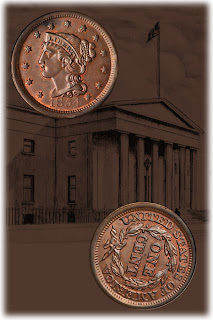Ask our Experts
Have a question about anything numismatic? Send it to Dave Bowers by e-mail and he will answer or will tap the talent of another staff member to do so. Questions of the most general interest (in our opinion) will be answered here, with just the sender’s initials.
 Question: Dear Dave, I see that “lists” are becoming popular in numismatics these days. I have copies of Whitman’s 100 Greatest United States Coins, 100 Greatest American Currency Notes, and 100 Greatest Medals and Tokens, and I suppose I will buy a copy of the next book in the series, if there is one. David Letterman has his lists, of course, not 100 items but ten, changing frequently. The Numismatic Bibliomania Society has come up with its own list of 100 great books. There are probably other lists of which I am not aware.
Question: Dear Dave, I see that “lists” are becoming popular in numismatics these days. I have copies of Whitman’s 100 Greatest United States Coins, 100 Greatest American Currency Notes, and 100 Greatest Medals and Tokens, and I suppose I will buy a copy of the next book in the series, if there is one. David Letterman has his lists, of course, not 100 items but ten, changing frequently. The Numismatic Bibliomania Society has come up with its own list of 100 great books. There are probably other lists of which I am not aware.Heeding your advice to build a numismatic library, can you give me a list of some early books, collectible and even hard-to-find, that would be worthwhile looking for? I am interested in American numismatics, which will limit the field, I know. —W.O.C.
Answer: Dear W.O.C., Nice question! The most durable of all 19th century references is Sylvester S. Crosby’s Early Coins of America, published in 1875. This discusses coins of the American colonies as well as copper and other coins of the states, ending with Washington issues of the 1790s. Believe it or not, this particular book has never become obsolete, and the basic information therein regarding enabling legislation, use of money in circulation, and more, cannot be found anywhere else, at least not easily. With regard to die varieties, rarity, and the like, there is updated information, including in the recent Whitman Encyclopedia of Colonial and Early American Coins, which I compiled with a lot of fine helpers.
Beyond Crosby, I like very much Montroville W. Dickeson’s American Numismatical Manual, published by Lippincott in 1859, with a second edition in 1860 and a third in 1865, the last two with the title word changed to Numismatic. In those early days of the hobby the word was not particularly well defined, and what we call a numismatist today, such as you and me, would have been called a numismatologist back then, and so on. The Dickeson book was the very first large format study of American coins. He compiled it essentially from scratch, as there was nothing particularly significant to draw upon. Although it necessarily contained errors, and for some reason was accorded very little honor in its own time (it was rarely cited in auction catalogues, for example), it is a dandy book simply to look through. Certain information concerning rarity and availability, and even some historical facts are somewhat off the mark, but it was a beginning effort and needs to be recognized as such.
Lyman H. Low’s Hard Times Tokens, published in 1899 and later update, is as readable now as it was back then. Low, a dealer and also a numismatic scholar, accepted the challenge to try to find out everything possible about these tokens, mostly the size of copper cents, struck from 1832 to 1855. This is one of my favorite texts.
Where to go from there? Probably to numismatic periodicals. I would suggest back issues of The American Journal of Numismatics, originated by the American Numismatic and Archaeological Society in 1866, and published until the second decade of the 20th century, at which time it dissolved, so to speak, and afterward individual monographs were issued. The glory days of the Journal were in the late 19th century, yielding an absolute wealth of interesting information. The Numismatist, first published in 1888, and still a magazine of importance, also furnishes interesting reading in its 19th century issues. Those from 1888 to 1893 are almost unobtainable, and later copies are usually seen here and there, not often as a run. Both the American Journal of Numismatics and The Numismatist would be good candidates for someone to issue on a CD or an Internet download. I realize this form of reading can be rather clumsy, but at least the information is preserved, and the cost would be nil.
Beyond these suggestions, which I feel are of universal appeal, you might want to review some information available from the Numismatic Bibliomania Society, and get some ideas. There are specialized publications on Washington items, merchants’ tokens, half dimes, and other niches. —Dave Bowers










